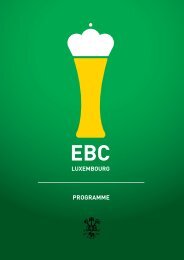here - the 34th European Brewery Convention
here - the 34th European Brewery Convention
here - the 34th European Brewery Convention
You also want an ePaper? Increase the reach of your titles
YUMPU automatically turns print PDFs into web optimized ePapers that Google loves.
P91<br />
Screening of brewing yeast strains for development of probiotic craft beers<br />
Dillemans Monique 1 , Van Nedervelde Laurence 1<br />
1 Institut Meurice, Brewing Department, Brussels, Belgium<br />
The aim of this work is to develop new barley malt functional beverages fermented by yeasts with<br />
probiotic physiological properties. Indeed, probiotic cultures have been used as preventive and<br />
<strong>the</strong>rapeutic agent for <strong>the</strong> treatment of diverse digestive diseases. The first selection among 25<br />
industrial brewing yeasts Saccharomyces cerevisia was based on <strong>the</strong>ir gastrointestinal tract tolerance<br />
(acid and basic pH, presence of bile salts and digestive enzymes). The most resistant strains were<br />
tested for <strong>the</strong>ir ability to ad<strong>here</strong> to human cells, <strong>the</strong>ir potential for induction of proinflammatory cytokine<br />
by intestinal cells and o<strong>the</strong>r criteria relevant for any potentially probiotic microorganism. Two<br />
pharmaceutical probiotic yeast strains, Saccharomyces boulardii were used as reference. Among<br />
brewing yeasts tested, three strains have proved <strong>the</strong>ir efficiency for high quality probiotic health beers<br />
production, with acceptable shelf life, depending on alcohol degree and storage temperature.<br />
P92<br />
Reactivation of exhausted yeast physiological activity<br />
Mario Novak 1 , Filip Cingesar 1 , Zvonko Petrović 2 , Philippe Cario 3 , Božidar Šantek 1<br />
1 University of Zagreb, Faculty of Food Technology and Biotechnology, Department of Biochemical<br />
Engineering, Zagreb, Croatia, 2 Ireks Aroma d.o.o, Zagreb, Croatia, 3 AEB SPA, Brescia, Italy<br />
Aims: The aim of this research was to prolong <strong>the</strong> yeast re-pitching process without loosing beer<br />
quality.<br />
Methods: In this research lager yeast (5 th generation stored at + 4 o C for 5 days) was used for wort<br />
fermentation w<strong>here</strong> yeast properties and metabolites concentrations were monitored. In order to<br />
reactivate yeast activity different nutrients mixtures (amino-acids, peptides, proteins, vitamins and<br />
minerals) were prepared.<br />
Results: The use of inorganic or organic nutrients mixtures insures that fermentation will be<br />
successfully completed compared to <strong>the</strong> fermentation without nutrients mixture. The use of organic<br />
nutrients mixture resulted in <strong>the</strong> increase of yeast concentration and in <strong>the</strong> reactivation of fermentation<br />
process. Reactivated yeast was also capable to perform a few more fermentations.<br />
Conclusions: The use of organic nutrients mixture can significantly improve exhausted yeast activity<br />
and to reactivate declined fermentation without considerable impact on <strong>the</strong> beer quality.<br />
P93<br />
Evaluation of Near-Infrared Spectroscopy (NIRS) for on-line determination of critical process<br />
parameters for fermentation process control<br />
Lucas Vann 1 , Johnathon B Layfield 1 , John D Sheppard 1<br />
1 North Carolina State University, Food, Bioprocessing & Nutrition Sciences, Raleigh, United States<br />
The search for improved methods for process control has led to <strong>the</strong> development and application of<br />
Near-Infrared Spectroscopy (NIRS). NIRS can be implemented in real-time with several<br />
determinations being made simultaneously from a single spectral scan t<strong>here</strong>by maximizing process<br />
monitoring and control capabilities. The present research explores its potential for on-line fermentation<br />
monitoring of specific gravity (SG), free amino nitrogen (FAN) and percent alcohol by volume (% EtOH<br />
v/v) for <strong>the</strong> purpose of control of fermentation rate and maturation time. Pilot-scale batch model





